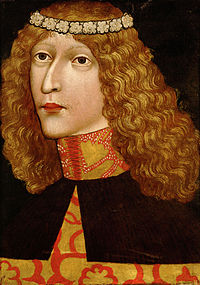Ladislaus the Posthumous Royalty
Ladislaus the Posthumous, known also as Ladislas (22 February 1440 – 23 November 1457), was Duke of Austria, and King of Hungary, Croatia and Bohemia. He was the posthumous son of Albert of Habsburg and Albert's wife, Elizabeth of Luxembourg. Although Albert, who ruled Austria, Hungary (including Croatia), and Bohemia, bequeathed all his realms to his future son on his deathbed, only the Estates of Austria accepted his last will. Fearing of an Ottoman invasion, the majority of the Hungarian lords and prelates decided to offer the crown to Vladislaus III of Poland. In Bohemia, the Hussite noblemen and towns denied to acknowledge the hereditary right of the late king's descendants to the throne, but did not elect a new king.After Ladislaus's birth, Queen Elizabeth flatly refused to cooperate with Vladislaus III of Poland. She had her infant son – known in Hungary as Ladislaus V – crowned king with the Holy Crown of Hungary in Székesfehérvár on 15 May 1440. However, the Diet of Hungary declared his coronation invalid and elected the Polish monarch king. A civil war broke out between the supporters of the two kings. Queen Elizabeth appointed her late husband's distant cousin, Frederick III, King of the Romans, Ladislaus's guardian. During the following years, Ladislaus lived in his guardian's court, mainly in Wiener Neustadt, where Aeneas Silvius Piccolomini (the future Pope Pius II) wrote a treatise of his education.After Queen Elizabeth died in late 1442, Ladislaus's interests were represeted by a Czech condottiere, John Jiskra of Brandýs, in Hungary, and by the leading Czech Catholic lord, Oldřich of Rožmberg, in Bohemia. Ladislaus's rival in Hungary, Vladislaus, fell in the Battle of Varna in November 1444. Next year the Diet of Hungary offered to acknowledge Ladislaus as the lawful king on condition that Frederick III renounce Ladislaus's guardianship. After Frederick III rejected the offer, the Diet of Hungary elected the military leader, John Hunyadi, regent in 1446. In Bohemia, the head of the moderate Hussites, or Utraquists, George of Poděbrady, took control of Prague in 1448. Frederick III attempted to prolong the period of guardianship, but the Estates of Austria forced him to resign and hand over Ladislaus to them in September 1452.After John Hunyadi also resigned the regency in early next year, royal administration was restored in Hungary. However, Hunyadi controlled most royal castles and royal revenues even thereafter. Initially, Ulrich II, Count of Celje (a cousin of Queen Elizabeth) was Ladislaus's main advisor, but Ulrich Eytzinger, a leading Austrian baron, forced the young sovereign to expel the count from his court. Ladislaus was crowned king of Bohemia on 28 October 1453, but George of Poděbrady prevented him from governing Bohemia. Eytzinger, Hunyadi and Poděbrady closely cooperated, but could not hinder a reconciliation between Ladislaus and Ulrich of Celje in early 1455. Ladislaus and Ulrich of Celje fled from Hungary before the Ottoman Sultan Mehmed II laid siege to Nándorfehérvár (now Belgrade in Serbia), but John Hunyadi relieved the fortress on 22 July 1456. Taking advantage of John Hunyadi's death, Ladislaus and Ulrich of Celje attempted to seize the royal castles and revenues from Hunyadi's son, Ladislaus. However, Ladislaus Hunyadi murdered Ulrich of Celje and forced the king to grant him an amnesty. With the consent of the royal council, the king had Ladislaus Hunyadi executed in March 1457. Hunyadi's relatives and supporters rebelled against Ladislaus who fled first to Vienna, then to Prague. He died unexpectedly in Prague. He was the last male member of the Albertinian Line of the House of Habsburg.
